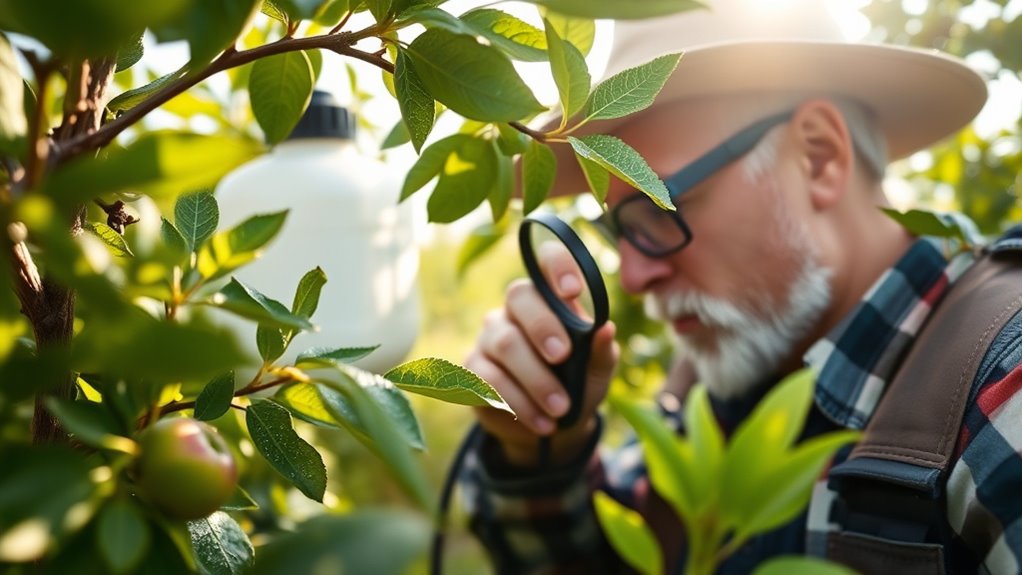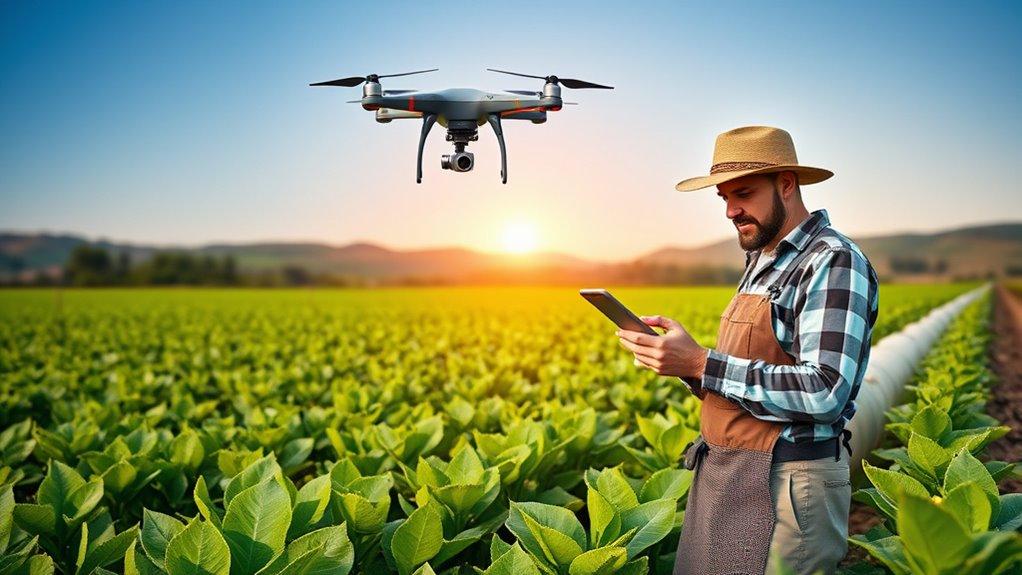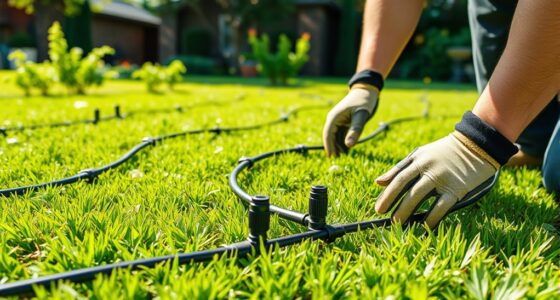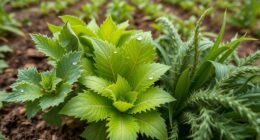To balance pesticide reduction with pest pressure, you should combine regular monitoring and understanding pest thresholds with cultural practices like crop rotation and sanitation. Using integrated pest management techniques, such as biological controls and resistant varieties, helps keep pest populations in check naturally. This approach minimizes unnecessary chemical use while protecting your crops. Staying vigilant with early detection methods lets you act only when needed, and if you explore further, you’ll find more ways to optimize your pest strategy effectively.
Key Takeaways
- Implement integrated pest management (IPM) strategies combining cultural, biological, and mechanical controls to reduce pesticide reliance.
- Regular monitoring and early detection enable targeted interventions, minimizing unnecessary pesticide applications.
- Understand pest activity patterns and thresholds to time controls effectively, balancing pest pressure with pesticide use.
- Use pest-resistant crop varieties and crop rotation to naturally disrupt pest cycles, reducing chemical dependency.
- Incorporate precision agriculture tools for targeted pesticide application, optimizing pest control while limiting chemical use.
Understanding Pest Dynamics and Thresholds

Understanding pest dynamics and thresholds is essential for effective pest management. You need to recognize how pest populations grow and fluctuate over time, influenced by environmental conditions and crop cycles. By observing pest behavior and population levels, you can identify when pests are likely to cause economic damage. Thresholds are specific population levels at which action becomes necessary to prevent unacceptable crop loss. Knowing these thresholds helps you decide when pesticide intervention is truly needed, avoiding unnecessary applications. This approach reduces chemical use, saves costs, and minimizes environmental impact. Monitoring pest activity closely allows you to develop targeted, timely responses. Additionally, staying informed about regional pest pressure statistics can improve your management strategies. Ultimately, understanding pest dynamics and thresholds empowers you to balance pest control with sustainable farming practices.
Strategies for Reducing Pesticide Use Safely

You can reduce pesticide use safely by adopting strategies like Integrated Pest Management, which combines multiple control methods to minimize chemical reliance. Crop rotation techniques help disrupt pest cycles naturally, lowering the need for pesticides. Implementing these practices together allows you to protect your crops while reducing environmental impact. Additionally, selecting the right projector type for your specific needs can optimize your setup, much like choosing the appropriate pest control methods enhances crop health.
Integrated Pest Management (IPM)
Have you ever wondered how farmers and pest managers can control pests effectively while minimizing pesticide use? Integrated Pest Management (IPM) offers a smart solution. It combines multiple tactics like monitoring pest populations, setting action thresholds, and using biological controls, such as beneficial insects. You focus on understanding pest biology and their environment to target interventions precisely when needed. Instead of relying solely on pesticides, IPM emphasizes prevention and cultural practices, like planting resistant varieties or adjusting planting times. When chemical controls are necessary, you choose the least toxic options and apply them carefully to reduce environmental impact. By integrating these strategies, you can keep pest levels manageable while reducing pesticide reliance, protecting ecosystems, and promoting sustainable farming practices.
Crop Rotation Techniques
Crop rotation is a powerful strategy for reducing pesticide use by disrupting pest life cycles and improving soil health. When you change crops each season, you prevent pests specialized on one plant from establishing strong populations. This natural break limits pest infestations and reduces the need for chemical controls. Additionally, rotating different crop families boosts soil fertility and structure, making plants more resistant to diseases and pests. You can plan rotations to include legumes, which fix nitrogen, and non-host crops that break pest cycles. Proper timing and diversity are key; rotating crops with different growth habits and root systems keeps pests off balance. Incorporating integrated pest management techniques further enhances pest control efforts while minimizing chemical reliance. By adopting crop rotation, you create a more resilient agroecosystem that minimizes pesticide reliance while maintaining healthy yields.
Integrated Pest Management (IPM) Techniques

You can effectively manage pests by monitoring their populations regularly to catch problems early. Incorporating biological control strategies, like beneficial insects, helps reduce reliance on chemicals. Additionally, cultural practices such as crop rotation can minimize pest buildup and support overall pest management. Implementing lifestyle strategies, like maintaining healthy plants and proper sanitation, can further enhance pest control efforts.
Monitoring Pest Populations
Monitoring pest populations is a essential component of effective Integrated Pest Management (IPM) techniques. By regularly inspecting your fields, you can identify pest presence early and determine their population levels. Use tools like visual scouting, sticky traps, and pheromone traps to gather accurate data. Keep detailed records of pest types, numbers, and locations to spot trends over time. This information helps you decide whether pest levels are below economic thresholds or if intervention is necessary. Monitoring prevents unnecessary pesticide applications, reducing chemical use and environmental impact. Be consistent and systematic in your approach, checking multiple areas and times of day. Effective monitoring empowers you to make informed decisions, balancing pest control with pesticide reduction efforts.
Biological Control Strategies
Biological control strategies play an essential role in reducing pesticide reliance by using natural enemies to suppress pest populations. You can introduce or enhance populations of predators, parasitoids, or pathogens that target specific pests, providing a sustainable pest management method. For example, releasing lady beetles to control aphids or using parasitic wasps against whiteflies helps keep pest numbers in check naturally. These strategies require careful identification of pests and their natural enemies to ensure compatibility and effectiveness. Biological control can be integrated with other IPM practices to create a balanced approach, reducing the need for chemical interventions. Regular monitoring of pest and natural enemy populations is crucial for assessing control success and adjusting strategies as needed, maintaining ecological balance while protecting crop health. Additionally, understanding pest dynamics and how they interact with natural enemies can improve the success of biological control efforts.
Cultural Pest Management
How can farmers effectively reduce pest pressure through cultural practices? You can do this by adjusting planting times, rotating crops, and managing field hygiene. These methods disrupt pest life cycles and make environments less hospitable. Proper spacing and pruning improve air circulation, reducing disease and pest habitats. Selecting pest-resistant varieties also minimizes damage without chemicals. Implementing these strategies consistently can lower pest populations naturally, reducing reliance on pesticides. Incorporating a variety of farming techniques such as cover cropping and biological controls can further enhance pest management efforts.
Monitoring and Early Detection Methods

Effective monitoring and early detection are crucial for managing pest populations and reducing pesticide use. By keeping a close eye on pest activity, you can catch problems early before they become severe. This proactive approach helps you target pests precisely and avoid unnecessary chemical applications. To do this effectively, consider these methods:
Monitoring pests early helps reduce chemical use and keeps crops healthy.
- Regular scouting: Walk through your fields or gardens frequently, looking for signs of pests or damage.
- Traps and monitors: Use sticky traps, pheromone traps, or other monitoring devices to detect specific pests early.
- Record keeping: Keep detailed logs of pest sightings, which help identify patterns and inform timely interventions.
- Understand pest behavior: Knowledge of pest activity patterns, such as peak times for movement or reproduction, can improve the effectiveness of your monitoring efforts. Pest behavior can vary based on environmental conditions and pest species, making tailored strategies essential.
Implementing these strategies allows you to stay ahead of pest outbreaks and apply control measures only when needed.
Benefits and Challenges of Reduced Chemical Reliance

Reducing reliance on chemical pesticides offers significant benefits, such as lowering environmental impact and promoting healthier ecosystems. When you cut back on chemical use, you help protect beneficial insects, soil health, and water quality. This shift can lead to more sustainable farming practices and improved biodiversity. However, you also face challenges. Reduced chemical reliance may result in increased pest pressure if alternative methods aren’t effectively implemented. You need to invest in integrated pest management strategies, which require knowledge, monitoring, and sometimes higher initial costs. Incorporating best practices like targeted application and crop rotation can help mitigate these risks. Balancing these benefits and challenges means carefully considering your pest pressures, crop types, and available resources. While reducing chemicals can be advantageous, it demands a thoughtful approach to prevent pest outbreaks and maintain crop yields.
Case Studies and Practical Applications

Real-world examples demonstrate how farmers successfully implement reduced pesticide strategies to manage pests effectively. These case studies highlight practical approaches that balance pest control with sustainability. For example, some growers use integrated pest management (IPM) techniques, combining biological controls, crop rotation, and targeted interventions. Others adopt precision agriculture tools, like drones and sensors, to monitor pest levels and apply treatments only when necessary. Additionally, understanding the shelf life of various juices helps ensure that harvested crops are stored properly, reducing waste and maintaining crop health.
Here are three practical applications:
- Using biological controls such as beneficial insects to reduce pest populations naturally.
- Implementing crop diversification to disrupt pest life cycles.
- Employing real-time monitoring to make data-driven pest management decisions.
These methods show that reducing pesticides doesn’t mean sacrificing crop health or yield.
Frequently Asked Questions
How Do Weather Patterns Influence Pest Populations and Pesticide Effectiveness?
Weather patterns directly impact pest populations and pesticide effectiveness. Warmer temperatures can accelerate pest life cycles, increasing populations quickly, while heavy rain can wash away pesticides, reducing their effectiveness. Humidity influences pest reproduction and disease spread, making pests harder to control. You should monitor weather forecasts closely, adjust application timing accordingly, and consider environmental factors to optimize pesticide use and minimize unnecessary applications.
What Are the Economic Impacts of Reducing Pesticide Use for Farmers?
Imagine you’re steering a ship through stormy waters—reducing pesticide use can save costs but risks crop loss. Economically, you might see lower input expenses, but pest outbreaks could lead to reduced yields and profits. You may also face higher labor costs for alternative methods. While some markets favor organic produce, others might penalize lower quality. Ultimately, balancing pesticide reduction impacts your bottom line, requiring careful planning and risk management.
How Can Farmers Balance Pest Control With Environmental Conservation?
You can balance pest control with environmental conservation by adopting integrated pest management (IPM) strategies. These include using biological controls, crop rotation, and selective pesticides. Regular monitoring helps you target pests effectively, reducing chemical use. Embrace sustainable practices, such as preserving natural habitats and minimizing chemical runoff. By staying informed and proactive, you protect your crops while safeguarding the environment for future generations.
Are There Legal Restrictions on Pesticide Reduction in Different Regions?
Yes, there are legal restrictions on pesticide reduction that vary by region. You need to check local, state, or national regulations, as some areas set limits on pesticide types, application methods, and usage levels to protect health and environment. Staying informed about these rules helps you reduce pesticides responsibly, ensuring compliance while still managing pests effectively. Always consult local authorities or agricultural extension services for guidance specific to your area.
What Role Does Biodiversity Play in Natural Pest Management?
Biodiversity acts like a bustling neighborhood, where a variety of species keep pest populations in check naturally. When you support diverse habitats, beneficial insects and predators thrive, reducing the need for chemical controls. By fostering plant diversity and natural habitats, you create a balanced ecosystem that manages pests effectively. This approach minimizes pesticide use, promotes healthy crops, and contributes to a resilient agricultural system that works with nature instead of against it.
Conclusion
Balancing pesticide reduction with pest pressure is vital for sustainable farming. By implementing IPM and monitoring pests early, you can cut chemical use while keeping pests in check. Did you know that farmers practicing reduced pesticide strategies see yields only 10% below conventional methods? Embracing these approaches helps protect your crops, environment, and future. Stay proactive, adapt your tactics, and you’ll find that effective pest management is both achievable and rewarding.










